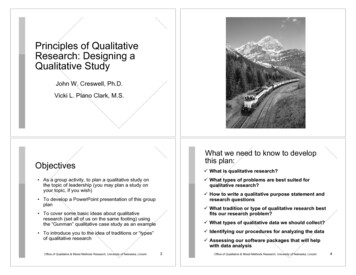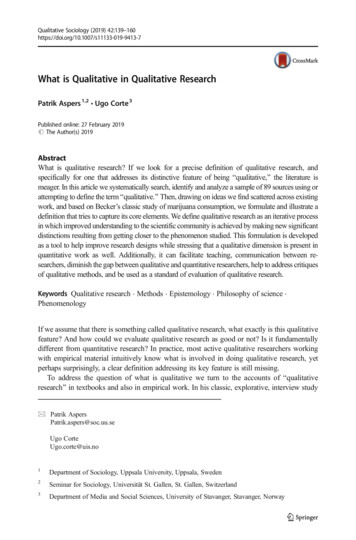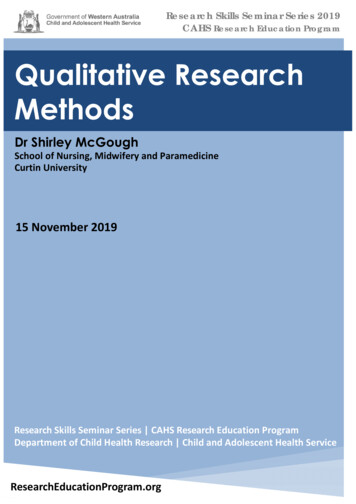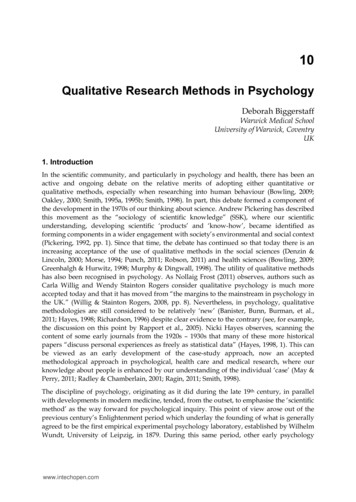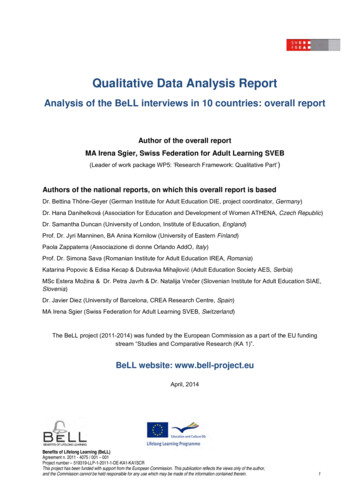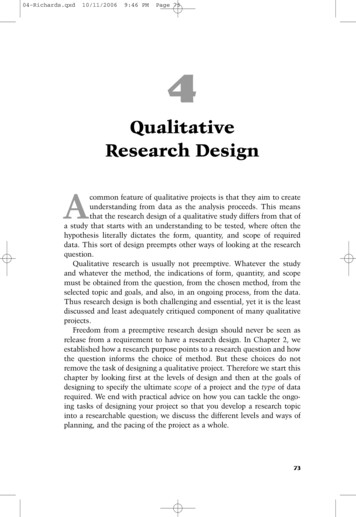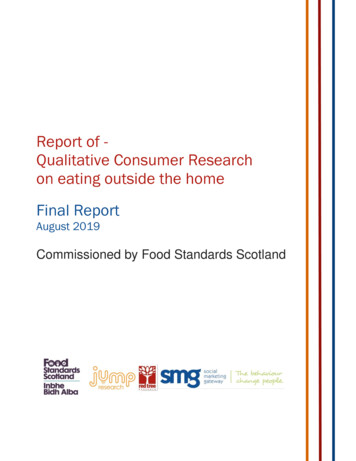
Transcription
Report of Qualitative Consumer Researchon eating outside the homeFinal ReportAugust 2019Commissioned by Food Standards Scotland
Table of Content1 Executive Summary2 Background3 Research Objectives4 Methodology5 Main Findings35.1 Current Behaviour and Attitudes- Eating Out of Home889General Observations Regarding OOH EatingA Summary of Key Positives and Negatives to Eating OOH from the Perspective of theRespondentsKey Conclusions in Relation to the Relative Positives and Negative of Eating OOHDo Those Who Eat OOH Want to Eat More Healthily When Out of Home?Attitudes When Prompted with the Reality of the Calorie Implications of Eating OOH asThey AreCurrent Behaviour and Attitudes- Eating Out of Home- Summary and Conclusions5.2 Views on Initiatives to Make Eating Healthier OOH EasierPotential Initiatives that Were Broadly SupportedPotential Initiatives that Were Received with Little Enthusiasm but were Not RejectedPotential Initiatives Rejected by Most RespondentsSummary Observations Relating to Potential Initiatives to Help Consumers Eat MoreHealthily When Out of HomeSpecific Exploration of Attitudes to Provision of Calorie InformationInitiatives to Support Parents and to Encourage Children to Eat More Healthily OOHSummary and Conclusions- Key Issues to Consider When Planning Policy InitiativesDesigned to Help Consumers to Eat More Healthily OOH55681112121516161717181822246 Appendices266.1 Recruitment Questionnaire6.2 Homework Template6.3 Topic Guide and Showcards6.4 Full breakdown of Audience Segment Profiles27333546FSS Out of Home Eating Consultation Qualitative Research2
1 Executive SummaryBackground, objectives and methodologyThis qualitative research was undertaken to explore consumer views on eating outside the home. Thisresearch complemented the Food Standards Scotland (FSS) public consultation on ‘proposals to improvethe out of home food environment’ which ran between November 2018 and February 2019.The methodology involved eight 90-minute focus groups, which included a total of 63 respondents. Groupswere held in Edinburgh, Glasgow, Dundee and Aberdeen (and involved respondents who lived and orworked in the cities, and out with the cities). The sample was drawn from lower socio economic groups (thatis ((C1)C2DEs) who ate out regularly and included younger people in Scotland (17-30 year olds), andparents of young children.FindingsViews on eating out of the homeIt is recognized that eating OOH was historically viewed as a treat that brought positive experiences at keymoments. Now eating OOH is seen an opportunity to indulge ourselves or an opportunity to relieve ourselvesof the daily stresses and pressures of life. As such, eating OOH is now felt to be something the people ofScotland ‘deserve’ in life as routines are perceived to be getting more pressured and frenzied.There are 6 main positives of eating OOH- it is easy to do, there is huge variety and choice, it can be a greattreat, foods eaten OOH can be very satisfying, eating OOH is a great way to enhance socializing, and eatingOOH can now be done at a lower cost and with greater value than ever before.The main negatives or drawbacks of eating OOH mirror the positives- the costs of eating OOH are recognizedto ‘add up’, it is perceived to fuel laziness and leads to a loss of cooking skills especially amongst youngerpeople, it can be less social than eating at home, and crucially, eating OOH is recognized as often being avery unhealthy way to eat due to- the types of food on offer, ingredients, cooking methods and portion sizes.Based on the research, it appears that most people who eat OOH want to eat more healthily when OOH,with the exception of many under 30 years old and those who have a general desire to live without anyrestrictions on their personal choices for life. That said, beyond the positives of eating OOH, as noted above,the research highlighted that many consumers also feel that healthy food is simply not as satisfying or tasty,not as available OOH and can be more expensive. As a result, at this time, it is felt to be too tempting to eatunhealthy foods when OOH.When prompted, the research highlighted that consumers found it difficult to assess how healthy foodsthat can be eaten OOH are in terms of how many calories they contain. This appears to be the caseespecially for foods that are perceived to be healthy (e.g. salads, yoghurts, vegan dishes). Whenrespondents were presented with the reality of how many calories can be consumed in typical dishes OOHthey were clearly shocked.The way forwardThe vast majority of respondents felt that it was a good idea to have calorie information presented at pointof sale for foods being sold OOH (including for take away foods, soft drinks and potentially alcoholic drinks).This initiative, it was felt, should be mandatory- with all businesses being required to provide calorieinformation at POS along with prices.Having calorie content displayed alongside foods sold OOH was felt to have the potential to be informative,helpful, persuasive and necessary in the long run for the benefit of society. Beyond the direct benefit to theconsumer it was felt that calorie information would have the knock on positive of encouraging businessesto reduce typical calories per offering.FSS Out of Home Eating Consultation Qualitative Research3
To ensure that the calorie provision initiative has the greatest potential impact, consumers feel that theinitiative should be supported by an education programme to help them understand and get the most valuefrom the information. In addition, the research showed that consumers feel it is important that the calorieprovision system be well policed to ensure credibility.Beyond calorie information provision, it was felt that more can and should be done to encourage the foodindustry in Scotland to limit ‘the risks’ of eating OOH. It was felt that this should be done through four keyinitiatives: The industry should provide more detailed information about the nutritional content of foods soldbeyond calories. That would be:o Through provision of more information on salt, sugar and fat contento With the industry being encouraged to provide this information, potentially in a traffic lightformat (as used in supermarkets), through a voluntary scheme Industry should be encouraged to increase the amount of healthy food they offer and as part ofthis to reduce the typical levels of fat, salt and sugar in the foods they sell OOH. Again, it was feltany programme that is set up to encourage reduction of unhealthy ingredients and increase theprovision of healthy foods should be voluntary In addition, industry should be encouraged or incentivised to reduce the cost of healthy foods beingsold OOHo It should be noted that while respondents felt they have easy access to unhealthy foods inlarge portions via promotional deals, they also feel that these deals provide good value. Assuch, respondents were very clear that they felt there should not be any restrictions onpromotions of foods, regardless of how unhealthy they are, for adults. Respondentspreferred the idea of greater choice and more value being offered via healthy promotionaldeals The research showed that consumers would support the idea of an award system that wouldencourage OOH eating businesses to be more conscious of the health needs of people in Scotlandand to help consumers chooseBeyond these potential policies that could benefit the adult population in Scotland, there is much moreopenness and support for wide-reaching legislation to force greater controls around what children areexposed to when eating OOH both for young children eating out with parents and for teens who are moreindependent. This was felt to be required as parental control is perceived to be weakening in modern societyin the face of the cleverness and persuasiveness of the OOH food industry. Caving in to their children isoften the path of least resistance to keep the peace for many parents.For children under about 10 years of age, children’s menus are currently seen as useful to have but, at thesame time, too often unhealthy. It is felt that children’s menus too often create poor eating habits andtastes from a very young age.The initiatives for children which saw strong support as mandatories are: Healthier children’s menus as standard Smaller, children’s portions allowed from the adult menu – without consumers being penalisedon price Limiting unhealthy choices, including via promotional offers (such as free ice cream orunlimited dessert etc.) Setting controls for businesses around schools to facilitate healthier choices and reduce theaccessibility of unhealthy choices for teensFSS Out of Home Eating Consultation Qualitative Research4
2 BackgroundBetween November 2018 and February 2019 Food Standards Scotland (FSS) undertook a publicconsultation on proposals to improve the Out of Home (OOH) eating environment for people in Scotland,which included asking views on initiatives to reduce calories and views on children’s food available outsidethe t-ofhome-environment-i/user uploads/fss---out-of-home---nov-2018-pdf.pdfThis report, commissioned by FSS and completed by Jump/ RedTree/ SMG research consortium (‘TheResearch Team’), provides additional contextual information from focus groups to complement the FSSpublic consultation.The broad definition of ‘Eating Out of Home’ used in this report is shown below:EATING DURING ANY TIME OF THE DAY AND FOR ANY PURPOSE- whether that be- breakfast, lunch,grabbing a snack, having a coffee and cake, or dinnerWITH FOOD BOUGHT FROM ANY TYPES OF BUSINESS: Cafes, bakeries, all types of restaurants, takeaways, pubs/bars, vending machines, workplacecanteens, hotels, leisure and entertainment venues Supermarkets and convenience stores who provide “food on the go” Places where one might purchase food when commuting or travelling Food delivery services, including onlineFood takeaways that may be ordered to eat at home also counted with regards to this study but eatingfood out of home that had been prepared at home (e.g. for a packed lunch or picnic) did not count.3 Research ObjectivesThe objectives for the qualitative consumer research fell into two categories: Generate a general, contextual understanding of the relationship between people in Scotland andeating out of home at this timeo Determine how current behaviour and attitudes to OOH eating will influence reactions tofuture initiatives to help reduce calorie intake while eating OOHGenerate an understanding of attitudes to potential initiatives that could encourage the people ofScotland to reduce calorie intake when eating OOH. Specifically looking at:o Attitudes to provision of calorie informationo Attitudes to provision of other consumer information alongside or instead of calorieinformationo Attitudes to initiatives to improving the way that food is presented to and sold to childrenFSS Out of Home Eating Consultation Qualitative Research5
4 MethodologyFor the qualitative research part of the consultation 8 group discussions were undertaken betweenFebruary 19th and 25th 2019. Each group discussion lasted approximately 90 minutes and involved 7 or 8respondents. All respondents were recruited by professional research recruiters, who lived near to thelocations of the groups. All respondents received a cash incentive of 45 to encourage attendance, as areward for completing a short homework task and to cover travel expenses.To help them prepare for the group discussions all respondents were given a short homework exercise tocomplete in the week before the research sessions. This exercise required them to keep a record of thenumber of occasions they ate out of home, when this was, who they were with, the occasion (i.e. whichmeal), whether they took advantage of any promotional deals and how healthy they regarded the food theyconsumed. Those eating out with children were also asked if they used children’s menus.A loose topic guide of questions was used to manage the discussions during the groups and to ensure thatall areas relating to the project objectives were covered. In addition, three discussion stimulation aids wereused during the groups. These were: A list of ideas that could be used to help people in Scotland eat more healthily or less unhealthilywhen OOHA calorie guessing exercise that required respondents to determine how many calories they thoughtwere contained in a selection of dishes that are available in OOH eating establishmentso Note- this exercise was developed from materials available from Diabetes UKA list of common dishes eaten OOH alongside an estimated range of calories that can be containedwithin the dishes depending on portion size, cooking method and ingredientso Note- this list was generated by FSS and used in their public consultationThe homework exercise template, topic guide and stimulus materials used in the groups are included inthe Appendix of this report.The SampleThe grid below presents a profile of the respondents recruited for each group discussion. As can be seen,the sample was recruited with a deliberate focus on population segments that could be more affected bychanges to OOH policy. The key groups included in the sample: Those in lower SEGs (that is (C1)C2DEs)o All respondents were in these less affluent SEGs, and as such they represented thepopulation segments potentially more likely to be affected by any changes in policy thatlead to price increases for OOH foodsYounger age groups (that is under 30 year olds)o Half of the group discussions included at least some respondents under 30 years of age.These respondents represented the demographic group that is understood to be the mostfrequent user of OOH eating establishmentsPeople eating out with childreno Four of the eight groups were recruited to ensure they all contained respondents withdependent children. These respondents represented the population sub-group that hasparticularly relevant views on children’s menus and other potential areas of policydevelopment that might influence how and what children eat OOHFSS Out of Home Eating Consultation Qualitative Research6
Group 1 – GlasgowGroup 2 – GlasgowFemales onlyMales & Females (50/50 split)20-40yrs36-50yrsAll with kids at homeMix of kids / no kidsC2DEC1C2DEat out regularly (mix of fast food, takeaways,Eat out regularly (mix of fast food, takeaways,coffee shops, bakeries, shops / supermarkets)*coffee shops, bakeries, shops / supermarkets)*Group 3 – EdinburghGroup 4 – EdinburghMales & Females (50/50 split)Males & Females (50/50 split)51-65yrs16-25yrsC1C2DC2DEEat out regularly (mix of fast food, takeaways,Eat out regularly (mix of fast food, takeaways,coffee shops, bakeries, shops / supermarkets)*coffee shops, bakeries, shops / supermarkets)*Group 5 – DundeeGroup 6 – DundeeFemales onlyMales & Females (50/50 split)16-25yrs51-65yrsC1C2DC2DEEat out regularly (mix of fast food, takeaways,Eat out regularly (mix of fast food, takeaways,coffee shops, bakeries, shops / supermarkets)*coffee shops, bakeries, shops / supermarkets)*Group 7 – AberdeenshireGroup 8 – AberdeenshireMales & Females (50/50 split)Males & Females (50/50 split)20-40yrs36-50yrsMix of kids / no kidsAll with kids at homeC1C2DC2DEEat out regularly (mix of fast food, takeaways,Eat out regularly (mix of fast food, takeaways,coffee shops, bakeries, shops / supermarkets)*coffee shops, bakeries, shops / supermarkets) **all respondents were recruited on the basis that they ate OOH “Frequently” (as defined by themselves)in at least two relevant locations: Eat in a restaurant Buy lunch from a supermarket / convenient store / Boots / Café/ Bakery etc Go to a fast food restaurant Go to a coffee shop (Starbucks / Costa / Café Nero etc) Buy crisps / sweets / chocolate bar / “a sweet treat” to eat out with your house (e.g. at lunch / onthe go / afternoon snack) Buy takeaway food to eat at homeA copy of the recruitment questionnaire used for this study is also included in the Appendix of this report.FSS Out of Home Eating Consultation Qualitative Research7
5 Main Findings5.1 Current Behaviour and Attitudes- Eating Out of HomeThis first part of the report outlines findings relating to the context to any future change to the OOHenvironment. This includes insights gathered relating to the relationship that respondents stated they havewith eating out of home. Significant parts of the insights gathered during this section of the research werebased on discussions about the homework exercises respondents had completed in advance of the groupsessions. This section also provides insights relating to respondents’ attitudes to the health implications ofeating OOH, including both front of mind attitudes and attitudes when prompted with data showing thepotential implications of eating OOH in terms of calorie consumption.General Observations Regarding OOH EatingAcross the research sample, a range of frequencies of eating OOH were reported, from those who ate outevery day, and sometimes for every meal, to those who ate out approximately three to four times per week.It was very clear from early in the discussions that respondents across all groups felt eating OOH was verynormal behaviour for them and for people like them in Scotland. This was clearly the case for all eatingoccasions but there were four eating out occasions that have, it was felt, become part of the norm forrespondents and Scottish society in recent years: Breakfasto Which was regarded as a much more routine purchase when OOH than in the pasto As an example, breakfasts on the go were regarded as an excellent way of saving time andmaking morning routines easierLuncho It was stated that buying sandwiches or other lunch options when OOH has largely replacedthe taking of packed lunches to work. The only exceptions to this trend were felt to be whenindividuals stated they were on a ‘diet’ and trying to control their weight, or, when on a tightbudget and money was trying to be savedCoffee and a snacko Grabbing a coffee on the go, when shopping or when travelling, was felt to now be a normfor many or most peopleo This type of behaviour was felt to be fuelled by the ubiquitous nature of coffee shopsEvening mealso There was no indication that most respondents regarded eating evening meals away fromtheir homes (other than for ‘special occasions’ or ‘treats’) as a new form of common ornormal behaviour. However, easy access to food that is prepared OOH, and deliveredthrough companies such as Just Eat and Deliveroo, does make non-preparation of eveningmeals more of a norm than in the pastIt should be noted that despite the general belief that eating OOH was a norm for all respondents (who itshould be remembered were recruited as people who eat OOH ‘frequently’), the degree of ‘commitment toeating OOH’ did appear to vary by lifestage. For example: Older respondents, that is those over 60-year olds, were the more likely to eat out least frequently.This segment of respondents typically ate out about 3 or 4 times per weeko The main motives for this segment for eating out appeared to be to treat themselves and/or to enhance their social livesParents, in the middle of the scale, appeared to be ‘conflicted’ in their attitudes to eating OOHFSS Out of Home Eating Consultation Qualitative Research8
On the one hand they, in the most part, try to still position eating OOH to their youngerchildren as a treat, while conceding that they are often fighting a losing battle with theirchildren, especially as their kids get into their teens, at which time they expect to eat outon a regular basis either for snacks or as full mealso On the other hand, parents appeared to embrace the opportunities that OOH eating offeredthem to provide escape from the pressures of life and or to give them a sense of personalfreedomThe population segment that clearly eats OOH most frequently was under 30-year oldso This group of newly independent young people stated that they are often eating out prettymuch all the timeo Beyond lifestage, the only other criteria that appeared to have a significant bearing on levels of eating OOHwas location of home. For those living in more rural settings it was clear that they ate out of home lessregularly, primarily as a result of having fewer opportunities to eat OOH in comparison to those living inmore urban settings.Despite the variations in commitment to eating OOH it should be noted that there was strong agreementamongst respondents that attitudes to eating OOH have totally changed in society. In the past, it was felt,eating OOH was regarded as a luxury or as a real treat. In contrast, eating OOH now is regarded as anacceptable norm on a far more regular basis. This was the case for all segments in the sample.To supplement this general description of the relationship that the research sample stated they have witheating OOH, a series of mini pen portraits of each of the key segments represented in the groups is providedin the appendix of this paper. Descriptions are provided of relationships with eating OOH for the followingsegments: Young newly independents - 17-30 year oldsYounger parents - 20-35 years of age, with children under 8 years of ageOlder parents - c30-50, with children beyond the children’s menu yearsOlder parents’ – with teenso Note - although dependent teens were not included in the sample it was clear that parentsof children in their early to mid-teens had very clear views on the way their teens eat OOHand, in turn, had concerns about how they ate OOH. As such, a mini profile of teens fromthe perspectives of their parents is providedOlder respondents and empty nesters - 50 yearsA Summary of Key Positives and Negatives to Eating OOH from the Perspective of the RespondentsFollowing a general discussion about how and where respondents eat OOH they were asked to outline whatthey felt were the main positives for or motives to eating OOH, and to describe the main negatives of eatingOOH. As can be seen below, respondents were clearly conflicted with regards to their attitudes to eatingOOH with many of the attractions to eating OOH mirrored by an opposite downside. Positives and facilitating arguments for eating OOH It is so easy- for time poor peopleo Eating OOH is convenient at so many levels- options are always close by or can bedelivered, there is no mess, and no waiting if required or desired Young people also felt a positive of eating out was that they don’t need to learnhow to cooko It is great if you are feeling lazy or tiredFSS Out of Home Eating Consultation Qualitative Research9
The variety and choice of food options available OOH are regarded as massive- with options beingavailable ‘almost everywhere’, and providing:o Different experienceso For all tasteso It was also felt that OOH food providers are getting better at accommodating for those withspecific requirements- including those who want to eat healthily, those who are vegetarianand vegan, and those who have food sensitivities and allergies In relation to this point it is worth noting that the provision of calorie informationon menus was spontaneously used as a good example of how some OOHbusinesses are becoming more conscious that some customers are looking forhealthier options. Across many of the groups, in all age categories, there seemedto be quite good awareness that businesses such as Pizza Express, Pizza Hut,Subway, Greggs, McDonald’s are putting calories on their menusEating OOH can provide an excellent treat- either as a ‘fancy meal’ or as an on the go indulgenceThe foods that can be consumed OOH can be very satisfying. That is, it is typically regarded as easyto get exactly what is desired and to the quantity that will be very fillingEating OOH is also regarded as a great platform to enhance social liveso This was regarded as the case for all types of social experience- as couples, with friends orcolleagues and with familiesThe OOH eating environment provides access to food at low prices and is perceived, often, toprovide excellent valueo Value was felt to be available for many different eating group types from those who areeating alone to familieso Respondents stated that value is recognised as being delivered through a variety ofvariables at different times including: Low prices, promotional deals, large portion sizes that provide the opportunity to‘really fill up’, quality in the form of good taste, quality in the form of freshingredients, and in terms of the overall experience that can be provided wheneating OOH as opposed to when eating at home Negatives and drawbacks to eating OOH Costs can ‘add up’ and be high both for individual eating experiences and for all eating experiencescombinedThe knock-on consequence of people eating out more regularly is that many lack the confidencearound cooking or simply don’t learn to cook in the first placeo For many respondents, this meant that cooking is perceived as a major hassle in busy liveso To amplify this point, it was noted in the groups with younger respondents that many didnot even understand the ‘before eating out was the norm’ concept. That is, many youngpeople felt that the era when everyone cooked every day from scratch was almost mysticalor lost in timeThe culture of eating out or buying take-away food is felt to fuel lazinessIn addition, as a contradiction to the perspective that eating out is an excellent platform forsocialising it was noted by many respondents, especially for those over 30 years of age, that eatingOOH can be actually less social than eating at home, when food is prepared carefully and in aconsidered way and where the whole experience is shared with family and friendsVery importantly in relation to this project it was also recognised, spontaneously, that many of thefood choices available to them and that they eat OOH are very unhealthyFSS Out of Home Eating Consultation Qualitative Research10
ooThis was primarily felt to be because the ingredients and cooking methods used mean foodeaten OOH is often not very nutritious and can be highly calorific. One respondents stated,‘it is rubbish’. While most respondents believed they know what is healthy, they find it easy todeflect its relevance to them and justify eating less healthy foods, when eating outof home, based on five perspectives: The ‘rubbish’ is significantly preferable, tastier and more satisfying than‘healthy stuff’ which is regarded as less tasty and bland- “just salad”o “I am not a rabbit” Younger Mum Aberdeen They can trade-off eating unhealthy foods when OOH by ‘promising’ to eathealthily at home They believe they deserve the more indulgent and less healthy treatswithin their ‘busy lives’ Also, eating more healthily is felt to be more expensive. With this being theperception for eating both in and out of home It was also felt to be more difficult to find and identify healthier optionsOOH, even if they are being soughtBeyond OOH eating options being regarded as often unhealthy due to the lack of nutritionalvalue, eating OOH is regarded as often unhealthy due to the amount of food consumed Respondents spontaneously recognised that for a typical meal or eatingexperience more calories will be consumed OOH than in home due to the amountof food eaten Many respondents across all segments in the sample recognised that is it too easyfor ‘us to ‘stuff’ ourselves’ when eating OOH- due to three factors: Portions being recognised as bigger Multiple courses (starter, main and pudding) or multiple component parts(e.g. sandwiches, crisps and chocolate) being taken as a norm And the engrained attitudes of ‘eat what you’re given’ or ‘take advantageof deals’- being accepted as ‘right’ Further to this, occasions for socialising can often be used to justify overindulgence. One respondent recognised that this attitude had been only typicallyprevalent on Christmas day, but it is now so on many eating out occasionsKey Conclusions in Relation to the Relative Positives and Negative of Eating OOHIt was clear from the groups that, historically, eating OOH was regarded as a treat that gave positiveexperiences. Now, however, the treat that eating OOH offers is more often about taking away daily stressand pressure- or just indulging. It can be observed that this shift in attitude fits in with the way that peoplein contemporary Scotland like to (or like to think that we) live our lives now. That is- busier, faster and morefuriously based on instant gratification.It can be observed that the basic direction of travel for eating OOH appears to be based on simple beliefs:Eating OOH is the norm in modern societyEating OOH is an excellent way tomake life easierEating OOH can be done far moreoften now than ever beforeubiquitous, low cost and goodvalueFSS Out of Home Eating Consultation Qualitative ResearchEating out can be justified as atreat that we deserve11
Do Those Who Eat OOH Want to Eat More Healthily When Out of Home?In advance of exploring strategy and policy options to help those who eat OOH eat more healthily,respondents were asked if they wanted to eat more healthily OOH. It was clear, that the majority ofrespondents did want to eat more healthily and live more healthily in general. This, as would be expected,was to allow them to look better, feel better, do more and live longer lives. The main exception to thisgeneral ideal was: Amongst respondents who stated that they were happy with who they are and how they live theirlives- and in turn, comfortable with how they eat:o The young singles segment of the sample was the most likely demographic group to holdthis beliefo In addition, those respondents who held a general belief that they should be able to livetheir lives the way they want, without social pressure, were also likely to state that they hadno immediate desire to live more healthy livesThat al
FSS Out of Home Eating Consultation Qualitative Research 3 1 Executive Summary Background, objectives and methodology This qualitative research was undertaken to explore
